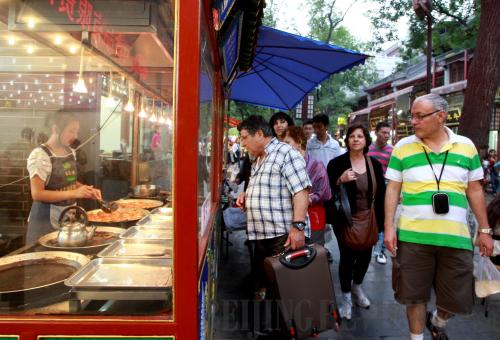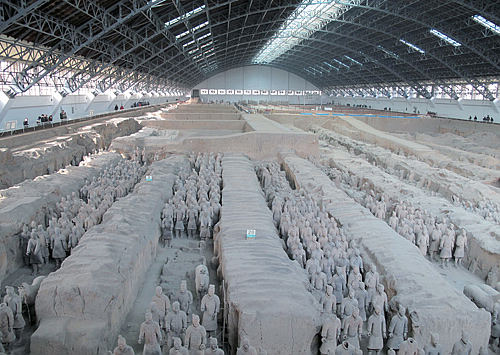|
 |
|
The Muslim Snack Street of Xi'an (JIANG XIAOYING) |
The long and extensive history of Xi'an, an ancient Chinese capital, has endowed it with an abundant variety of cultural sites and artifacts, including the world renowned Terracotta Warriors and the Mausoleum of Emperor Qinshihuang.
Today, Xi'an has become a world famous tourist city and an inexhaustible treasure house on par with ancient capitals like Athens, Cairo and Rome. Each year, about 40 million people from across the globe visit the city to expand their knowledge of Chinese civilization.
Xi'an, capital of northwest China's Shaanxi Province, is one of the most well-known capitals of ancient China. The city, previously called Chang'an, served as the capital for 13 Chinese dynasties, including the most prosperous dynasties of the Zhou (1046-256 B.C.), Qin (221-206 B.C.), Western Han (202 B.C.-A.D. 24) and Tang (618-907). Now, more than a thousand years later, Xi'an has grown into a large metropolis with a population of more than 1 million.
 |
|
Terracotta Warriors (WANDI) |
Among the attractions of Xi'an, the Terracotta Warriors sit on top of the list. Discovered in 1974 in the Lintong District of Xi'an, the archeological find from the Qin Dynasty, praised as the eighth wonder of the world, includes a clay-made standing army of 7,000 life-size soldiers, horses, chariots and weapons. Arranged in battle formations, the soldiers guard the tomb of Emperor Qinshihuang, the first emperor of the Qin Dynasty. The grand mausoleum and the clay warriors and horses buried underground for over 2,000 years have amazed every visitor since they were unearthed.
The warriors aren't Xi'an's only major tourist attraction. The city wall from the Ming Dynasty (1368-1644), the Big Wild Goose Pagoda, the Small Wild Goose Pagoda, Famen Temple, Great Mosque and Huaqing Hot Spring are all not to be missed.
As one of the symbols of the ancient city, the city wall is one of the last completed structures of its type still standing in China. The wall stands 12 meters tall and stretches 13.7 km in length with a deep moat surrounding it. Every 120 meters, there is a rampart which extends out from the main wall. The city wall is said to be one of the largest ancient military defensive systems in the world.
The Big Wild Goose Pagoda, located in the city's south, is a well-preserved ancient Buddhist shrine originally built in 652. As a holy place for Buddhists, the pagoda attracts countless visitors looking to worship or for a quick photo. And the Small Wild Goose Pagoda, which was built in the year 707 during the Tang Dynasty, is newer and smaller than the big one. It is dainty and exquisite in its appearance compared with the bigger one.
Huaqing Hot Spring, one of China's most famous hot springs, is another must for visitors to Xi'an. From the Tang Dynasty, this hot spring had been a favorite among emperors of successive dynasties, as well as a place to enjoy scenic beauty.
Xi'an is rich in delicious Shaanxi snacks and various delicacies from other parts of China. The Muslim Snack Street, near the Drum Tower, boasts numerous small shops, an open-air market and plenty of vendors cooking up a slew of snacks. No trip to Xi'an is complete without tasting yangrou paomo, a soup served with bread and delicious mutton. Guantang baozi, steamed buns filled with tasty stuffing, and rou jia mo, finely chopped pork stuffed in toasted wheat flour flat bread, are also famous local snacks.
To accommodate the rising number of tourists, the local tourist industry has expanded in recent years. Finding a convenient and cozy place to stay is easy, with numerous star-rated hotels and youth hostels lining the streets and quaint back alleys. To date, Xi'an has 113 star-rated hotels, including eight five-star hotels and 23 four-star ones. |
